Improving the accuracy of admitted subacute clinical costing: an action research approach
Sharon Hakkennes A C , Ross Arblaster A and Kim Lim BA Knowledge and Information Services, Barwon Health, PO Box 281, Geelong, Vic. 3228, Australia. Email: rossa@barwonhealth.org.au
B Visasys Pty Ltd, PO Box 751, Glen Waverley, Vic. 3150, Australia. Email: kim@visasys.com.au
C Corresponding author. Email: sharonh@barwonhealth.org.au
Australian Health Review 41(4) 443-448 https://doi.org/10.1071/AH15063
Submitted: 20 March 2015 Accepted: 6 July 2016 Published: 29 August 2016
Journal Compilation © AHHA 2017 Open Access CC BY-NC-ND
Abstract
Objective The aim of the present study was to determine whether action research could be used to improve the breadth and accuracy of clinical costing data in an admitted subacute setting
Methods The setting was a 100-bed in-patient rehabilitation centre. Using a pre-post study design all admitted subacute separations during the 2011–12 financial year were eligible for inclusion. An action research framework aimed at improving clinical costing methodology was developed and implemented.
Results In all, 1499 separations were included in the study. A medical record audit of a random selection of 80 separations demonstrated that the use of an action research framework was effective in improving the breadth and accuracy of the costing data. This was evidenced by a significant increase in the average number of activities costed, a reduction in the average number of activities incorrectly costed and a reduction in the average number of activities missing from the costing, per episode of care.
Conclusions Engaging clinicians and cost centre managers was effective in facilitating the development of robust clinical costing data in an admitted subacute setting. Further investigation into the value of this approach across other care types and healthcare services is warranted.
What is known about this topic? Accurate clinical costing data is essential for informing price models used in activity-based funding. In Australia, there is currently a lack of robust admitted subacute cost data to inform the price model for this care type.
What does this paper add? The action research framework presented in this study was effective in improving the breadth and accuracy of clinical costing data in an admitted subacute setting.
What are the implications for practitioners? To improve clinical costing practices, health services should consider engaging key stakeholders, including clinicians and cost centre managers, in reviewing clinical costing methodology. Robust clinical costing data has the potential to be used beyond mandatory reporting requirements; however, health services need to balance the cost of improving their costing data with the additional value obtained from that data.
Additional keywords: activity-based funding.
Introduction
Hospital spending is the fastest growing area of government spending. Health expenses comprise 19% of Australian government expenditure and grew by 76% in real terms between 2002–03 and 2013–14.1 This growth is not sustainable and cuts in healthcare funding are inevitable.1 Improving efficiency in health care service delivery is one way in which health expenses can be reduced. Access to robust clinical costing data is critical in evaluation of the efficiency of healthcare services.2
The discipline of clinical costing studies the cost and mix of resources used to deliver patient care and includes both direct and indirect costs. Methods of costing include patient-level costing (‘bottom-up’ costing) and cost modelling (‘top-down’ costing).3 Patient-level costing involves identification and allocation of costs directly to individual patient episodes. This minimises assumptions used to allocate costs, thereby achieving more accurate cost allocation at an individual patient level. Cost modelling derives a unit of cost for patient episodes by dividing total expenditure by a measure of volume (per case mix, per episode or per diem). It assumes an equal distribution of resources between patients and therefore differences in individual patient utilisation do not result in different costs being assigned.
In Australia, funding for admitted and non-admitted hospital activity is based on an activity-based model. The overarching goal of activity-based funding (ABF) is to provide a national platform for accurate and transparent allocation of funding to health services based on activity performed.4 The Independent Hospital Pricing Authority (IHPA) is the body responsible for the development of the pricing framework that has been used in the implementation of ABF in Australian public hospitals.5
Admitted subacute activity includes palliative care, rehabilitation and geriatric evaluation and management (GEM) care types. For admitted subacute activity, the Australian National Subacute and Non-Acute Patient (AN-SNAP) classification system is used nationally in the ABF model.
In Victoria in 2012–13, admitted subacute rehabilitation activity was funded according the Casemix Rehabilitation and Funding Tree (CRAFT). CRAFT funding includes episode and bed-day payments, with patients categorised as either Rehabilitation Level 1 (amputee, major health injury and spinal patient’s first rehabilitation episode) or Rehabilitation Level 2 (all other care types). GEM and palliative care are not components of the CRAFT funding model and were funded on a per diem basis.6
In 2013–14 several changes were made to Victorian funding models to bring them closer to the national model. For admitted subacute care, an interim funding and pricing model, the interim Subacute Non-Acute Classification (i-SNAC) pricing model, has been introduced that is uniform across all admitted subacute programs and replaces funding by bed-day prices and the CRAFT.7
The IHPA uses cost and activity data to develop a cost model that is used as the basis for the pricing model for admitted subacute care. Thus, accurate estimation of costs for specific health services is required to protect against undesired consequences that may affect the delivery and quality of health services.8 Calculation of accurate unit costs relating to patient episodes of care relies on the accurate allocation of both direct (e.g. drugs) and indirect (e.g. support services) costs. However, there is a lack of consensus as to the best method for collection and calculation of heath service costs for the price-setting process9 and a lack of robust clinical costing data for admitted subacute episodes of care to inform the calculation of price weights for the AN-SNAP classification system.10
The aim of the present study was to review current costing processes within a large regional health service and determine whether action research could be used to improve the breadth and accuracy of clinical costing data in an admitted subacute setting. Our hypothesis was that an action research approach would be effective in improving the type, number and accuracy of activities costed.
Methods
Setting
The setting for the present study was a 100-bed rehabilitation facility providing admitted subacute care within a large regional healthcare service. Care provided includes GEM, palliative care, neurological, orthopaedic, amputee, traumatic brain injury, spinal cord injury, pain and general rehabilitation.
Within the organisation, activity data for clinical costing is collated from clinical information systems, billing information and clinical coding information. These data are collated and provided to an external consultancy firm to complete the costing process. A mixed-cost modelling and patient-level costing approach is used to allocate costs. Clinical costing is completed on an annual basis at the conclusion of each financial year.
Study design
A pre-post study design was used. A process of participatory action research was used to guide the review, revision and evaluation of admitted subacute clinical costing methodology used for the 2012–13 financial year. Action research is a collaborative process with a focus on engaging practitioners with the research and subsequent implementation activities.11 It brings together action, reflection, theory and practice in a systematic way in order to create practical knowledge that is of value to those involved in the project.12
The study was approved by Barwon Health’s research ethics committee.
Phases of action research
There were five action research phases used in the present study (Fig. 1), with Phase 1 commencing at the start of March 2014 and Phase 5 concluding at the end of June 2014.
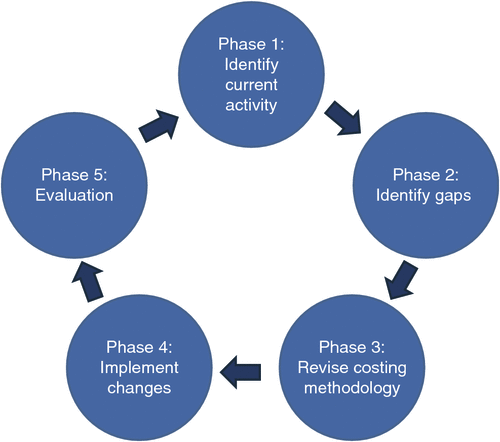
|
Phase 1
To determine current activity associated with admitted subacute episodes of care, key stakeholders were identified within each of the areas of nursing, medical and allied health. Individual stakeholder meetings were held and data were collected using a standardised template to identify current activities, cost drivers, cost centre allocations and data collection methods. Limitations of current data collection methods were documented and methods for improved data capture were identified.
In addition, cost centre managers and business managers were consulted, as appropriate, to clarify specific details to cost drivers and cost centre allocation for specific activities, and business analysts were consulted to clarify issues around data capture and submission.
Phase 2
Using information obtained as a result of the stakeholder engagement in Phase 1, the 2012–13 financial year clinical costing activity, cost drivers and cost centre allocation were reviewed to identify discrepancies between actual activity and costed activity.
Phase 3
Key stakeholders were again consulted to report findings relating to the current discrepancies in activity and costing processes.
Using this information, stakeholders were engaged to review their existing work practices and to identify and develop: (1) methods for improved data capture; (2) cost drivers to ensure activity was accurately costed to the service and cost centre; and (3) areas in which cost weighting of activities could be applied.
Phase 4
Key stakeholders, business analysts and the clinical costing consultant worked together to implement changes in data capture, cost drivers and apply relative value units developed as a part of Phase 3 of the project.
Phase 5
To review the effect of the revision of the costing process on the accuracy of the costing data, alignment of the revised costing information was compared with Victorian state averages for each of the care types.
Clinical costing processes were re-run based on the revised cost drivers and weights. Because it was not possible to modify costing data, all episodes of care that commenced before the 2012–13 financial year, and their associated costs, were excluded from this analysis.
In addition, a medical record audit was conducted to determine whether the changes made improved the accuracy of the costing methodology. Eighty episodes of care (approximately 5% of the total sample) included in the 2012–13 admitted subacute in-patient costing were randomly chosen for inclusion in the audit using a computer generated random number table. Random selection was used to prevent any bias in selection with regard to demonstrating increased benefits of the revision of the costing methodology that occurred within the encounter matching. To be matched to the episode, in-patient utilisation needed to fall within the length of stay, plus the day before and the day after the episode. Activity data for that episode of care were extracted retrospectively from the medical records and compared with the activities costed to that episode of care derived from the encounter-matched clinical costing extract.
Cost data were coded to be accurate if the activity occurred during the in-patient stay, as indicated in the medical record. The audit was restricted to counting the number of different (e.g. physiotherapy, pathology etc.) activities rather than the total number of activities (e.g. number of minutes of physiotherapy intervention, number of pathology tests) because it was beyond the scope of the present study to review the data in this level of detail.
Statistical analysis
Descriptive statistics were used to describe the demographic details of the episodes of care included in the audit and in the total sample. A paired t-test was used to determine the effect of the revised linking rules and costing process on the accuracy of the costing data, as measured by the number of activities costed, the accuracy of activities costed and the number of activities missing from the costing.
The threshold for statistical significance was set at P = 0.05. Statistical analysis was performed using Stata statistical software Version 12 (StataCorp).
Results
Over 30 key stakeholders were engaged as a part of this project. Stakeholders included clinicians, operational managers, business managers, business analysts and clinical support staff. Although it was not formally measured, generally the clinical stakeholders possessed minimal pre-existing knowledge of the clinical costing process (and that it even occurred) and how their activity and data captured related to this activity contributed to the costing process.
Key changes made in the clinical costing methodology and outstanding issues identified are outlined in Table 1.
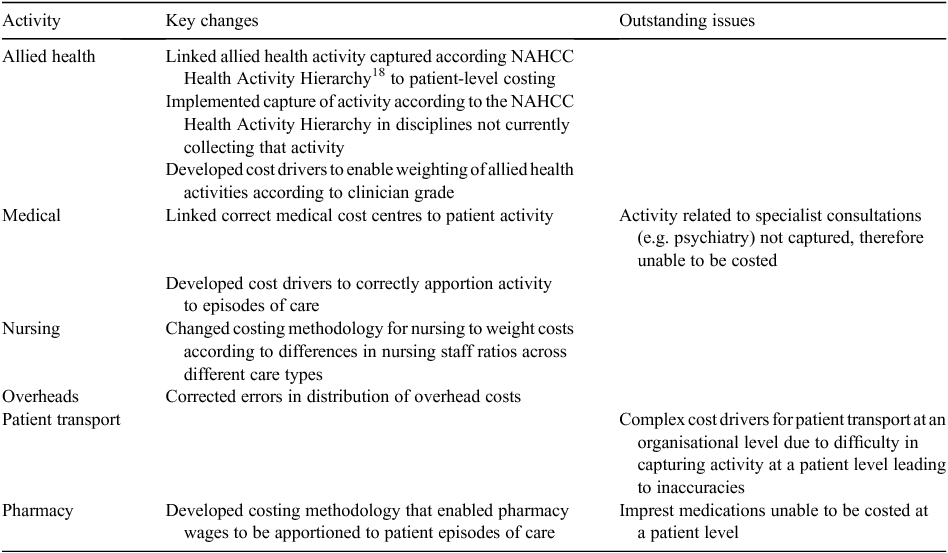
|
After removing 99 episodes of care (52 Rehabilitation Level 2, 13 palliative care and 34 GEM) that were admitted before the 2013–14 financial year, 1499 separations were included in the revised costing process.
Review of the clinical costing process for subacute in-patient care and improving alignment of clinical costing reduced the variation in the costing across Rehabilitation Levels 1 and 2, palliative care and GEM compared with the state average (Fig. 2). This improvement in alignment is reflected in the comparison of average cost per bed-day for all separations with the state average. In the original costing, the admitted subacute average cost per bed-day was 22% less than the state average (A$587.57 cf. A$745.60), whereas in the revised costing the average cost per bed-day (A$791.87) was 6% greater than the state average.
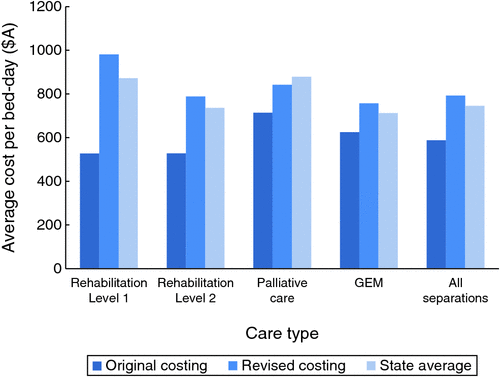
|
The 80 subacute in-patient episodes of care included in the medical record audit were representative of the total sample (Table 2).
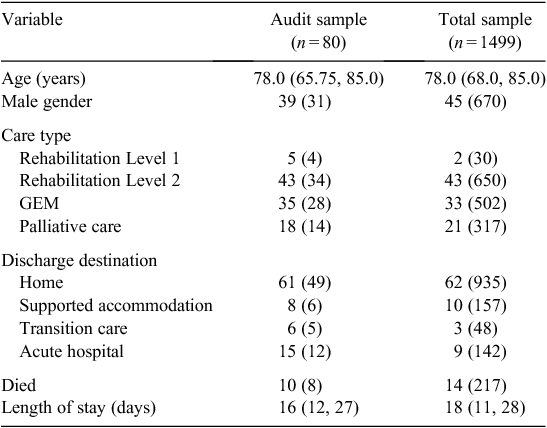
|
The medical record audit demonstrated that the revision of the clinical costing improved the accuracy of the costing data. This is illustrated by a statistically significant increase in the average number of activities costed, as well as a statistically significant reduction in the average number of activities incorrectly costed and the average number of activities missing from the costing (Table 2).
Prior to revision of the clinical costing rules, 579 different activities were costed to the 80 episodes of care reviewed in the medical record audit. This increased to a total of 887 in the revised costing. This increase in the number of activities reflects the inclusion of several core activities in rehabilitation not previously linked to the in-patient episodes of care, including the addition of allied health services, which were largely missing from the original costing data.
Of the 579 activities costed in the original costing, 38% (222) were incorrectly costed to the episode of care (i.e. the activity did not occur in the episode of care). The majority of errors in the costing related to incorrect costing of medical specialties (such as acute general medicine staff to GEM episodes of care). In addition, in the small proportion of episodes of care where allied health services were costed, often the costs were linked to the wrong cost centre. In the revised costing, 13% (111) of the 213 activities costed were incorrect. Because no patient-level data were available for 2012–13 with regard to psychology and neuropsychology service provision, costs for this service were distributed across all episodes of care. Thus, 75 of the 111 activities incorrectly costed in the revised costing were related to these services. Data are now being captured at a patient level for psychology and neuropsychology to address this issue in the future.
The medical record audit also demonstrated that there was a significant reduction in the number of activities that were not costed in the post-implementation audit (Table 3). A large number of the 539 activities missing from the original costing were allied health activities. Seventy-nine of the 80 episodes of care audited had allied health input (usually multiple disciplines) but only 26 of the episodes of care audited had any allied health activity included in the original costing. The main activities included in the 120 missing from the revised costing related to single allied health disciplines where data had not been captured in the patient data management system for the activity, patient transport costs and medications.
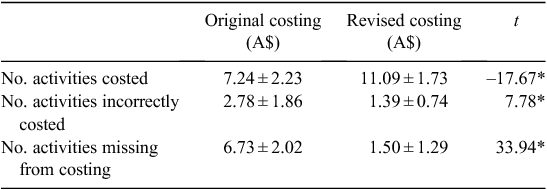
|
Discussion
In Victoria, hospitals have been submitting clinical costing data since 1992. Clinical costing data form one of the key building blocks of ABF and, increasingly, costing data are being used more broadly. For example, recently the Grattan Institute used costing data obtained from the National Hospital Cost Data Collection to analyse the efficiency of acute public hospital care delivery and identify avoidable costs.2 Thus, it is imperative that costing data are robust.
In the present study, using an action research approach, the review of admitted subacute in-patient activity, data capture and cost drivers for the 2012–13 admitted subacute episodes of care resulted in statistically significant improvements in the accuracy of the costing data. In addition, the revision of the costing allocation substantially reduced the variation between the average bed-day costs for all admitted subacute activity care types and the state average.
Hospital activity is not static, in order to meet constant changing demands on hospital services and government-set hospital targets, organisational structures evolve, new services are implemented and cost centre allocations can change. Victorian healthcare organisations are required to complete costing methodology in line with the Australian Hospital Patient Costing standards produced by the IHPA.13 Current clinical costing standards recommend regular review of clinical costing results with refinement of costing methods for subsequent costing periods.13 Engagement of clinicians in costing processes allows allocation of costs in greater detail, facilitating analysis of activity and its resource consumption, thus actively supporting the management of cost.14 This project demonstrated the value of engaging clinicians and cost centre managers in developing clinical costing methodology. These key stakeholders were essential in the revision of the clinical costing process because of their inherent understanding of their activities and how data related to these activities were captured at a local level. This enabled substantial improvements in costing methodology to be implemented across all clinical groups (medical, nursing, allied health and pharmacy) in a relatively short period of time, without additional resources.
In response to issues identified with the robustness of non-admitted and admitted subacute costing data, the IHPA recently commissioned a costing study to collect a definitive baseline dataset of patient-level cost data for non-admitted and admitted subacute activity.10 Data were collected across 43 sites in Australia for a 12-week study period in 2013. The resulting average bed-day rate for all admitted subacute care types was calculated as A$719.53. This rate is lower than the revised costing rate of A$791.87 reported in the present study. The IPHA study included psychogeriatric and maintenance care types that were not included in the present study; this may account, in part, for some of this discrepancy.
It is mandatory for Victorian public hospital services to submit clinical costing data for use at both a state and federal level on an annual basis. Traditionally, costing data have been used to inform healthcare payment systems, enabling prices and funding mechanisms to be developed.15 However, the value in clinical costing data is far greater than this. In Australia, the costs of health care are growing at an unsustainable rate and funding growth may continue to be constrained.1 Improving hospital efficiency will be essential in managing budgets into the future. Patient-level costing is an accurate way of deriving costs incurred against income earned. This level of data has the potential to engage clinicians, by clarifying the link between clinical decisions and aspects of efficiency and cost-effectiveness.16 Thus, access to robust clinical costing data in conjunction with clinical outcomes data at a local level could not only facilitate review of current service efficiency, but it could also assist with activities such as service planning, benchmarking and evaluation.
A large number of improvements were made in the costing methodology that increased the accuracy of the costing data in the present study and thus improved the potential for costing data to be used beyond mandatory reporting requirements. However, due to the complexity of the healthcare environment, several issues were identified within the costing methodology that were unable to be rectified within the scope of the present study. Although allocation of costs at a patient level provides greater detail of costs with increased accuracy than cost modelling, the cost of collecting and the time taken to produce these data are much higher.17 The decision regarding cost accounting method is a compromise between accuracy and cost-effectiveness9 and organisations need to balance the benefit of improved costing information against the additional cost and complexity of obtaining it.3
The present study used an action research approach to improve costing methodology, and changes in the accuracy of the costing data were assessed using a medical record audit. Although the results were positive, some caution must be exerted when generalising the findings to other care types and hospitals. There was no formal assessment of the stakeholders engaged in the project with relation to their knowledge of clinical costing methodology or their perceived value of clinical costing data. Anecdotally, the general understanding of clinical costing in health and how these data are used was low among the stakeholders engaged in the present study. Further investigation is warranted into the knowledge and understanding of clinical costing of healthcare clinicians and cost centre managers and the relationship between this and the accuracy of clinical costing data.
Conclusions
In Australia, access to robust clinical costing data is essential in determining the price models used in ABF. Beyond mandatory reporting requirements, accurate clinical costing data can be used at a local level for activities such as benchmarking and evaluating the efficiency of services. The present study demonstrated that an action research approach to engage key stakeholders and review clinical costing methods in an admitted subacute setting was effective in increasing the breadth and accuracy of clinical costing data in this setting. Further research is warranted into the effectiveness of this approach in other settings.
Competing interests
None declared.
Acknowledgement
The authors acknowledge the Victorian Department of Health for providing funding for this project
References
[1] Daley J, McGannon C, Hunter A. Budget pressures on Australian governments, 2014 edition. Melbourne: Grattan Institute; 2014.[2] Duckett SJ, Breadon P, Weidmann B, Nicola I. Controlling costly care: a billion dollar hospital opportunity. Melbourne: Grattan Institute; 2014.
[3] Jackson T. Cost estimates for hospital inpatient care in Australia: evaluation of alternative sources. Aust N Z J Public Health 2000; 24 234–41.
| Cost estimates for hospital inpatient care in Australia: evaluation of alternative sources.Crossref | GoogleScholarGoogle Scholar | 1:STN:280:DC%2BD3cvisFyitA%3D%3D&md5=b2c4987172136f0afd1785f64f688ed7CAS | 10937398PubMed |
[4] Independent Hospital Pricing Authority. The pricing framework for Australian public hospital services 2014–2015. Canberra: Commonwealth of Australia; 2013.
[5] Health Policy Solutions. Activity based funding for Australian public hospitals: towards a pricing framework. Sydney: Independent Hospital Pricing Authority; 2011.
[6] Department of Health. Victorian health policy and funding guidelines 2012–13. Melbourne: Department of Health; 2012.
[7] Department of Health. Victorian health policy and funding guidelines 2013–14. Part one – key changes and new initiatives. Melbourne: Department of Health; 2013.
[8] Waters HR, Hussey P. Pricing health services for purchasers – a revew of methods and experiences. Health Policy 2004; 70 175–84.
| Pricing health services for purchasers – a revew of methods and experiences.Crossref | GoogleScholarGoogle Scholar | 15364147PubMed |
[9] Raulinajtys-Grzybek M. Cost accounting models used for price-setting of health services – an international review. Health Policy 2014; 118 341–53.
| Cost accounting models used for price-setting of health services – an international review.Crossref | GoogleScholarGoogle Scholar | 25082465PubMed |
[10] Ernst and Young. National non-admitted and subacute admitted costing study. Sydney: Independent Hospital Pricing Authority; 2014.
[11] Meyer J. Using qualitative methods in health related action research. BMJ 2000; 320 178–81.
| Using qualitative methods in health related action research.Crossref | GoogleScholarGoogle Scholar | 1:STN:280:DC%2BD3c7gtVKrsg%3D%3D&md5=8d8354882117e214acd299147b0f267dCAS | 10634744PubMed |
[12] Reason H, Bradbury H. Handbook of action research: participative inquiry and practice. London: Sage; 2007.
[13] Independent Hospital Pricing Authority. Hospital patient costing standards. Version 3.1. Canberra: Commonwealth of Australia; 2014.
[14] Chapman CS, Kern A. Costing in the National Health Service – from reporting to managing. London: Imperial College London; 2010.
[15] Chapman CS, Kern A, Laguecir A, Angelé-Halgand N, Angert A, Campenale C, Cinquini L, Doyle G, Garrot T, Hansen A, Hartmann F, Hinz V, Mateus C, Perego P, Sikkut R, Tenucci A, Quentin W. International approaches to clinical costing. Bristol: Healthcare Financial Management Association; 2013.
[16] Blunt I, Bardsley M. Patient-level costing – can it yield efficiency savings? London: Nuffield Trust; 2012.
[17] Waters H, Hussey P. Pricing health services for purchasers – a review of methods and experiences. Washington, DC: The World Bank; 2004.
[18] National Allied Health Casemix Committee. Health activity hierarchy – version 1.1. Melbourne: RMIT University; 2001.


